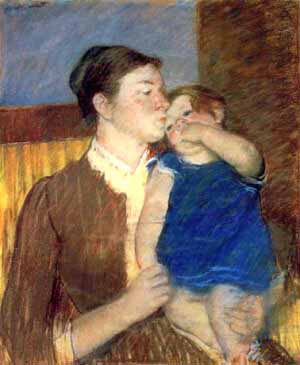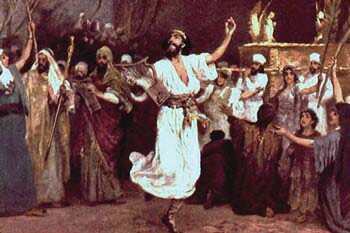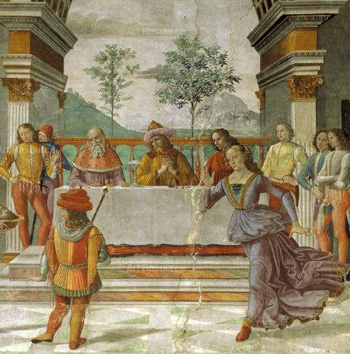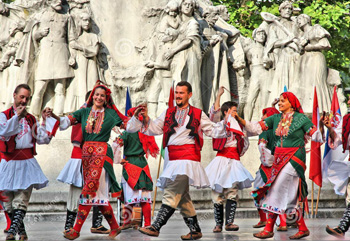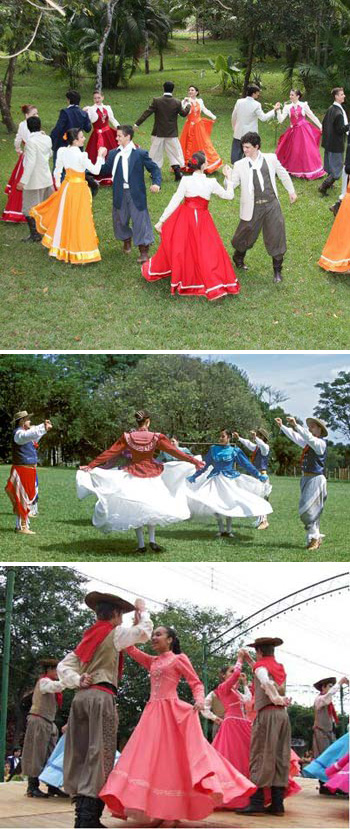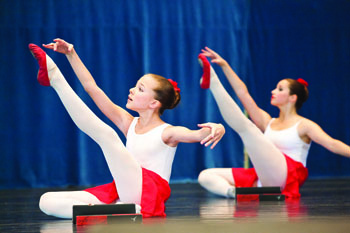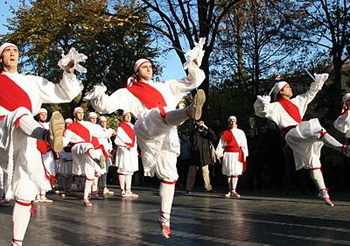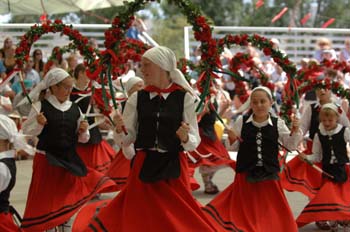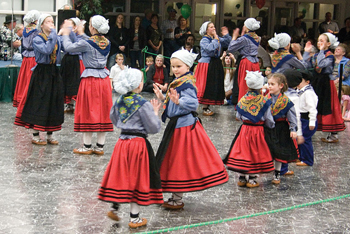How Relation Is
Crucial in Human Knowledge, the Sacraments, Signs, and History
In 1970 Cardinal
Ratzinger wrote in his book Introduction to Christianity,
Christian thought discovered the
kernel of the concept of person, which describes something other and
infinitely more than the mere idea of the “individual.”
Let us listen once more to St. Augustine: “In God there are no
accidents, only substance and relation.”1
Therein lies concealed a revolution in man’s view of the world: the
sole dominion of thinking in terms of substance is ended; relation
is discovered as an equally valid primordial mode of reality.”2
When
I first came across this quotation, I was studying Thomistic
philosophy at Gonzaga, and although I wasn’t a traditionalist at
the time, my first reaction to this quotation was a kind of
unreflective
outrage. I just felt
within me that Ratzinger was saying something philosophically wrong,
that some sort of liberal or modernist tendency of
his
was polluting pure Thomistic natural philosophy, which obviously
placed substance as primary and accidents as secondary. Now,
a few years later, I must admit that he was right, and his insight
contains a
key component of the solution to the modernist crisis.
Let
me turn to another thinker, quite different than Ratzinger, the
Canadian philosopher John Russon, who is well known for his
philosophical and historical work on Hegel. Russon states what has
become of the modern man:
One
of the ideas with which we are most comfortable in our everyday life
is the idea that we are self-enclosed, independent beings. We
strongly defend our claim to being self-possessed, insisting that
“it’s my view, and I have a right to it”, or “that’s mine”,
or “I’ll do what I like”. In each case, we identify ourselves
as the “I” who is in charge of its own affairs, which means an “I
with a unique point of view, with a unique body, and with a unique
will to initiate actions. On this view, it is up to each one of us to
determine who we are and what we shall do. If this is what we are
really like, then tradition has little intrinsic value: if we are in
full self-possession, then traditions do not bind us or direct us or
generate us, but are at most amusing objects of observation.3
We
see contained in this statement a summary of all modern political
philosophy, such
as is found in Rousseau,
and philosophy of human nature. We see in it the inevitable
separation between Church and state. All liberalism and modernism,
the
nominalism of Ockham, the immanence of Luther and the Reformers, the
rationalism of Descartes are contained here. Here is the mentality of
the “cafeteria Catholic,” who picks and chooses according to his
internal whims. Here is the pseudo-spirituality of the New Age as for
example in practitioners of The
Secret,
who judge the value of any pursuit with whether they feel that they
are remaining in a state of “high vibration,” which is simply the
subjective sense of an absence of stress and the presence of
pleasure. Here
is the viral popularity of
the idea that one can “love Jesus and hate religion,” a
notion which
excludes the social, traditionally defined aspects of spirituality
for the sake of an individual relationship defined by the arbitrary
decisions of the individual. This
is what happens when man’s real relation to reality is severed.
I
believe that on a fundamental level, all of reality can be understood
in terms of substances with their accidents and the various kinds of
relations that exist on different levels of reality. The reason for
this is that reality is a faint reflection of its Creator, and its
Creator is a single Divine substance and a Trinity of relations.
Hence in creation, it is substance and relation at its root. This
needs fleshing out and careful qualification, all of which cannot be
done in a short talk, so for today, I want to consider two main
points:
1. Changes in the conceptual understanding of relation has had
significant impact on the development of Western civilization.
2.
The health of a society may be judged by the relations it maintains
in its philosophical worldview, in politics, and in religion.
The
earliest systematic discussion of relation begins with Aristotle in
chapter 7 of his short work the Categories.
In this work, Aristotle is seeking to establish the different ways in
which reality exists by itself and can be spoken about intelligibly.
He’s looking at the largest “categories” of mind-independent
reality, the dimensions that cannot be reduced to others. He arrives
at his basic distinction between substances and accidents. Substances
are individual, existing things. Accidents are properties or
characteristics existing
in
substances, properties such as quantity (having a certain height or
weight),
quality (being a certain color), location, time, position (seated or
standing), etc. One of those categories is relation.
Aristotle
defined relation as being towards something else
(pros ti). The Latin
phrase is ad aliquid,
towards something. Relations are that by which something is related
to another thing.
Now
how are relations related to Sacraments, knowledge,
history,
etc.? After Aristotle, the idea of relation is covertly imported into
theological discussions about the nature of the Sacraments, which
are quickly seen to be a kind of symbol or sign.
Even in the New Testament, St. Paul speaks of how Baptism and the
Eucharist refer not only to the effects they bring about but how they
also symbolize certain aspects of Christ’s life. For example,
Baptism is a symbol of participating in Christ’s death and
resurrection (Rom. 6:3-11). The Eucharist is a symbol of the unity of
the Church (1 Cor. 10:17). Marriage is a symbol of the bond between
Christ and the Church, His Bride (Eph. 5:22-23).
In
other words, the Sacraments are signs. What is the unique nature of a
sign? Origen in his commentary on the Letter to the Romans says, “A
sign is a visible something that suggests the idea of another
invisible thing.”4
St. Augustine defines sign in
a similar manner in book 2 of De doctrina christiana:
“A sign is a thing which causes us to think of something beyond the
impression the thing itself makes upon the senses” (Signum
est enim res praeter speciem, quam ingerit sensibus, aliud aliquid ex
se faciens in cogitationem uenire).5
What we see in this
definition of sign is the reality of relation. Without relation,
which brings one thing towards another, a sign could never bring us
to another thing.
As
St. Augustine and
many other Church Fathers show,
there are multiple relations in a Sacrament: the relation of matter
to form, the relation of the sacramental rite to the spiritual
effects that it causes, the relation of the sacrament to the church
in general. But
essential to the notion of Sacrament is that it is a sign of a
certain sort. In
fact, the importance of defining a Sacrament in terms of the sign led
the theologian Pierre
Pourrat
to state, “[W]henver the definition departed from the idea of sign,
it lost something of its precision.”6
It
is from these theological considerations, along
with debates on how God relates to creation and the nature of the
Trinity, that the notions of
relation and sign were further developed in the medieval era.
I
will pass over the various complexities, but suffice it to say, the
scholastics quickly realized that Aristotle’s account of relation
was inadequate and admitted of numerous exceptions. Aristotle’s
definition of relation applied to what the scholastics called
“predicamental relation,” a real relation existing between two
physical subjects. This tree is similar to that tree. But if the
second tree were cut down, the relation would cease because there no
longer is a second tree to compare to. However,
the scholastics noticed at least two other forms of relations that
Aristotle did not account for: relations between two mental entities,
such as concepts in the mind, such
as in
mathematical equations, and
relations between one physical entity and a mental entity, such as
the knowledge of the value of a coin.
Key
insights developed during the 13th
century on the nature of knowledge that form the basis of realism as
opposed to future epistemologies based on faulty philosophical views.
The
immediate object of sensory awareness is the external world. In this
process, the human observer enters into multiple relations with his
environment. Scholastics realized, however, that the relation between
man and his environment in the process of knowledge was one more form
of relation that went against Aristotle’s defintion! Nothing
on the part of physical reality is modified by our coming to know it,
but we change as we come to know reality; hence there is no such
thing as the “right side of a column” except relative to someone
viewing a column from the right side: the change is in the perceiver,
not the column.
14th
century nominalism changes things. Ockham begins a process sometimes
called the “progressive
‘mentalization’
of sign.”7
Peter
of Ailly summarizes this shift by saying that the concept is “the
very act itself of knowing the thing.” This move, which flattens
the process of human cognition, beginning with pre-conceptual
sensation and moving to successive levels of differentiation in
perception and then intellection, is precisely what leads to
Descartes’ rationalism when the latter claims that “ideas are the
only immediate objects of my sensory awareness” (“Sixth
Meditation,” n. 6). Ockham rejects the notion that relations exist
independently of the mind and without realizing it, thus cuts man off
from external reality. On
the other hand, Ockham strangely upholds the notion that things can
be related to each other independently of the mind, the rejection of
which would mean that there could be no such thing as act and
potency, causality, or identity:
The
intellect does nothing to bring it about that the universe is one, or
that a whole is composed [of its parts], or that causes in spatial
proximity [to their effects actually] cause [their effects], or that
a triangle has three [sides], etc. …any more than [the intellect]
brings it about that Socrates is white or that fire is hot or water
cold.8
It
is likely that Ockham’s involvement in the political-religious
dispute between John XXII and the Holy Roman Emperor Louis IV of
Bavaria prevented Ockham from realizing the full implications and
almost self-contradictory aspects of his thought. For if relations
themselves are merely products of the mind, then man is immediately
cut of from reality.
We
come now to the second contention of mine, namely, that the health of
a society may be judged by the relations that issue from its
collective worldview, especially philosophical, political, and
religious. The
progression from
late scholastic nominalism
towards the principle of immanence, in which man is the source and
measure of all reality, is very straightforward. Due to the severing
of man and reality because of the mentalization of the sign and the
reduction of relations to mere beings of reason, which are products
of the mind, man can no longer be informed by external reality. He
now exists on his own. Thus
we return to the dawning of modern thought, the core of which is
immanentism.
Ratzinger
rightly noted the ever increasing emphasis or tyranny of substance in
metaphysics. Descartes
defined substance as a “thing that exists in such a way that it
doesn’t depend on anything else for its existence”9
and
thus rendered substance as absolutely self-existing, without the need
of God. Spinzoa in fact would notice this logical consequence of
Descartes’ definition and from it develop his own philosophy of
monistic pantheism. Leibniz, describing
his own version of substance, called a monad,
famously said that they “have no windows,” that is, no relation
to external reality. He wrote:
Strictly
speaking, one can say that no
created substance exerts a metaphysical action or influx on any other
thing.10
And:
There
is no way of explaining how a monad can be altered or changed
internally by some other creature, since one cannot transpose
anything in it, nor can one conceive of any internal motion that can
be excited, directed, augmented, or diminished within it, as can be
done in composites, where there can be change among the parts. The
monads have no windows through which something can enter or leave.11
Not
only man, but every substance in reality becomes increasingly
isolated and cut off from each other. Every man for himself. The
traditional Catholic writer Roger Buck points out that this all leads
to what he calls Enlightenment
Despair.
He
cites the poem “Aubade” (pronounced: oh-bawd) by Philip Larkin:
I
work all day, and get half-drunk at night.
Waking
at four to soundless dark, I stare.
In
time the curtain-edges will grow light.
Till
then I see what’s really always there:
Unresting
death, a whole day nearer now,
Making
all thought impossible but how
And
where and when I shall myself die.
Arid
interrogation: yet the dread
Of
dying, and being dead,
Flashes
afresh to hold and horrify. […]
This
is a special way of being afraid
No
trick dispels. Religion used to try,
That
vast moth-eaten musical brocade
Created
to pretend we never die,
And
specious stuff that says No
rational being
Can
fear a thing it will not feel, not
seeing
That
this is what we fear—no sight, no sound,
No
touch or taste or smell, nothing to think with,
Nothing
to love or link with,
The
anaesthetic from which none come round.
As
Buck strikingly puts it, “Here is the work of a man in
hell—suffering acutely from the deathly vacuum [that] materialism
has generated. May God have mercy on his soul and the souls of all
those afflicted by the same terrible dread, ennui and
meaninglessness.”12
The
late Neothomistic
philosopher W. Norris Clarke, SJ, said that being naturally enters
into relations with other beings because it is the means by which a
being shares its “ontological richness” with another, a process
necessary for the sustaining of all substances.13
Clarke
along with a few other philosophers developed the insight based on
St. Thomas’s metaphysics that every being in its respective manner
simultaneously contains self-perfective and self-communicative
dynamics.14
If it is intrinsically self-communicative, then that being is
intrinsically relational; thus esse
in is
simultaneously and always esse
ad aliud,
being towards or for another, and being towards
implies being from
(esse
ab alio).
Communicativity implies the capacity for receptivity (esse
ab)
as a complement even if the former is not always actually attained
between subjects. Receptivity, then, is a
necessary condition,
for without it a being could not advance towards its full
development. Thus
there is a micro-trinity within substance: esse
in,
which is the substance itself, but also esse
ad and
esse
ab,
for every finite substance comes from something else and will be the
agent of different causal chains, or at least potentially can be. And
the whole arrangement and relation of each substance to each is
necessary for the flourishing of all finite being, at least when all
is properly ordered according to their natures. Of course, given the
fallen state of creation, this doesn’t always attain, but its
potential remains rooted in the natures of things, which are both
existing in themselves as a unity and existing towards others as a
relation.
The
recovery of the universality and import of relations not only in
abstract metaphysics but in day-to-day relations, in religion, in
politics is an essential task for Catholics. We say that man is a
microcosm of the universe, but we must also see how man is a
microcosm of the Trinity, and when in a state of grace, he actually
contains the Trinity and stands in a supernatural relation with the
Trinity, a relation that all men are called to by the mercy of God.
Virtue,
prayer, and the proper formation of the intellect all orient man back
into reality and establish him more and more firmly in relation to
his end, which perfects him. If
civilization is the fruit of the habitual orientation of a society in
right relations with God, each
other, and each man to himself,
then it is the re-establishment of these right relations that will
restore civilization.
This
leads us to the importance of tradition. Tradition is the means by
which each generation is related to the past, to
the intellectual and cultural riches of the past, and
from this relation to properly orient ourselves to the future.
And
here also is the importance of Sacred Tradition. We defend Sacred
Tradition because it is the only sure means to come
into a proper relationship towards
God, and by means of which save our souls as St. Ignatius put it at
the beginning of his Spiritual
Exercises.
Maintaining
right relations in the present depends on following the sound wisdom
and accumulated knowledge of the past, which forms the intellect and
guides it to maintain a proper perspective of reality as
it enters the future.
Footnotes:
1 St.
Augustine, De Trinitate,
5.5.6.
2 Joseph
Ratzinger, Introduction to Christianity (New York, NY: Herder
& Herder, 1970), 132, 137.
3 John
Russon, “Hegel and Tradition,” in Hegel and Tradition: Essays
in Honour of H. S. Harris, ed.
by Michael Baur and John Russon (Toronto: University of Toronto
Press, 1997), 3, quoted in John Deely, Four Ages of
Understanding (Toronto:
University of Toronto Press, 2001), 658.
4 Origen,
In epist. ad Rom., 4.2.
5 St.
Augustine, De doctrina christiana,
2.1.1.5-7.
6 Pierre Pourrat, Theology of the Sacraments: A Study in Positive Theology
(St. Louis, MO: B. Herder, 1910), 36.
7 Stephan
Meier-Oeser, “Medieval Semiotics,” in Stanford Encyclopedia
of Philosophy, accessed 28 Jan.
2017.
8 William
of Ockham, Ordinatio I,
d. 30, q. 1 in Opera
Theologica iv,
316-317.
9 René
Descartes, Principles of Philosophy, ed. Jonathan Bennett,
http://www.ahshistory.com/wp-content/uploads/2012/07/descprin.pdf,
I.51.
10 Leibniz,
Primary Truths (1689), A 6.4:1647/AG 33.
11 Leibniz,
Monadology, n. 7, G VI 607:
AG 213-214.
12 Roger
Buck, Cor Jesu Sacratissimum
(Kettering, OH: Angelico Press, 2016), 36.
13 Cf.
Norris Clarke, “Person, Being, and St. Thomas,” Communio
19 (Winter 1992), 605.
14 Cf.
W. Norris Clarke, The One and the Many: A Contemporary Thomistic
Metaphysics (Notre Dame, IN: University of Notre Dame Press, 2001).
